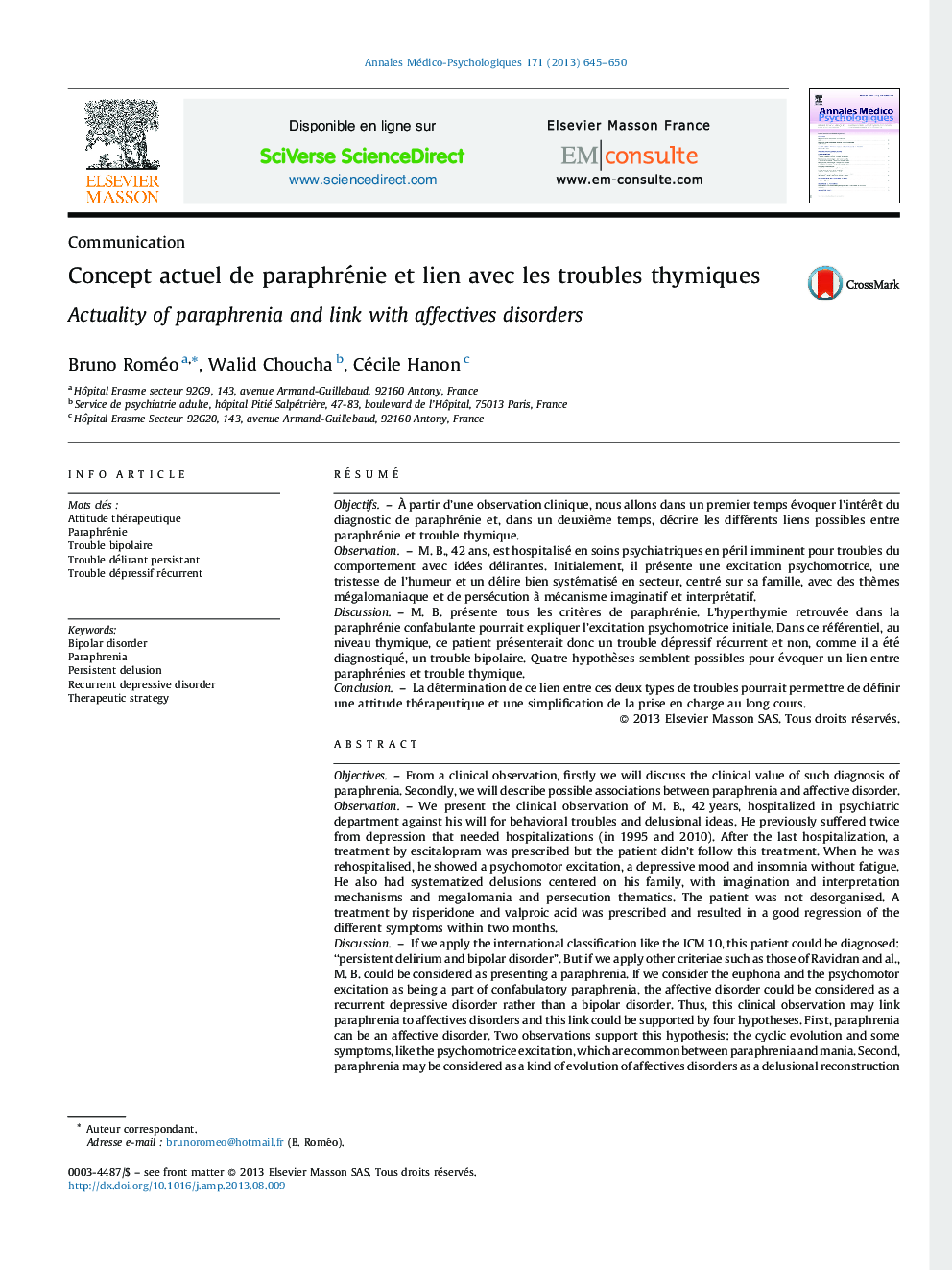| کد مقاله | کد نشریه | سال انتشار | مقاله انگلیسی | نسخه تمام متن |
|---|---|---|---|---|
| 314876 | 535476 | 2013 | 6 صفحه PDF | دانلود رایگان |

RésuméObjectifsÀ partir d’une observation clinique, nous allons dans un premier temps évoquer l’intérêt du diagnostic de paraphrénie et, dans un deuxième temps, décrire les différents liens possibles entre paraphrénie et trouble thymique.ObservationM. B., 42 ans, est hospitalisé en soins psychiatriques en péril imminent pour troubles du comportement avec idées délirantes. Initialement, il présente une excitation psychomotrice, une tristesse de l’humeur et un délire bien systématisé en secteur, centré sur sa famille, avec des thèmes mégalomaniaque et de persécution à mécanisme imaginatif et interprétatif.DiscussionM. B. présente tous les critères de paraphrénie. L’hyperthymie retrouvée dans la paraphrénie confabulante pourrait expliquer l’excitation psychomotrice initiale. Dans ce référentiel, au niveau thymique, ce patient présenterait donc un trouble dépressif récurrent et non, comme il a été diagnostiqué, un trouble bipolaire. Quatre hypothèses semblent possibles pour évoquer un lien entre paraphrénies et trouble thymique.ConclusionLa détermination de ce lien entre ces deux types de troubles pourrait permettre de définir une attitude thérapeutique et une simplification de la prise en charge au long cours.
ObjectivesFrom a clinical observation, firstly we will discuss the clinical value of such diagnosis of paraphrenia. Secondly, we will describe possible associations between paraphrenia and affective disorder.ObservationWe present the clinical observation of M. B., 42 years, hospitalized in psychiatric department against his will for behavioral troubles and delusional ideas. He previously suffered twice from depression that needed hospitalizations (in 1995 and 2010). After the last hospitalization, a treatment by escitalopram was prescribed but the patient didn’t follow this treatment. When he was rehospitalised, he showed a psychomotor excitation, a depressive mood and insomnia without fatigue. He also had systematized delusions centered on his family, with imagination and interpretation mechanisms and megalomania and persecution thematics. The patient was not desorganised. A treatment by risperidone and valproic acid was prescribed and resulted in a good regression of the different symptoms within two months.DiscussionIf we apply the international classification like the ICM 10, this patient could be diagnosed: “persistent delirium and bipolar disorder”. But if we apply other criteriae such as those of Ravidran and al., M. B. could be considered as presenting a paraphrenia. If we consider the euphoria and the psychomotor excitation as being a part of confabulatory paraphrenia, the affective disorder could be considered as a recurrent depressive disorder rather than a bipolar disorder. Thus, this clinical observation may link paraphrenia to affectives disorders and this link could be supported by four hypotheses. First, paraphrenia can be an affective disorder. Two observations support this hypothesis: the cyclic evolution and some symptoms, like the psychomotrice excitation, which are common between paraphrenia and mania. Second, paraphrenia may be considered as a kind of evolution of affectives disorders as a delusional reconstruction scarring. Nodet even described the paraphrenia post-mania and the paraphrenia post-depression. Third, patient with a paraphrenia may be more prone to develop an affective disorder and the delusional disorder mixing reality and imaginary elements may result in difficulties for the adaptation to environmental stress. Fourth, same risks factors such as genetic or epigenetic factors, emotional deprivation and/or social isolation are common to paraphrenia and affective disorder. However, paraphrenia is frequently associated with cluster A personality disorder (paranoiac and schizoid) while affective disorder are more linked to cluster B personality disorder (borderline).ConclusionThe efficacy of a treatment combining neuroleptic and mood stabilizers and the preservation of social insertion are important and indicate a therapeutic strategy that is different from schizophrenia. Thus, the determination of a link between paraphrenia and affective disorders could allow better therapeutic strategy and better follow-up on the long run.
Journal: Annales Médico-psychologiques, revue psychiatrique - Volume 171, Issue 9, November 2013, Pages 645–650